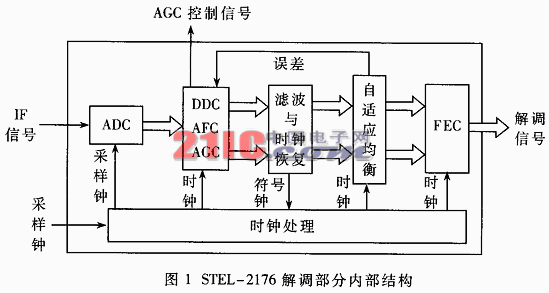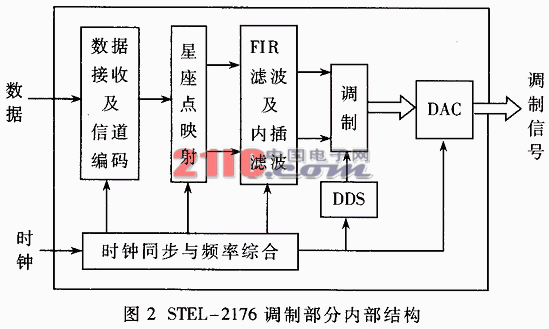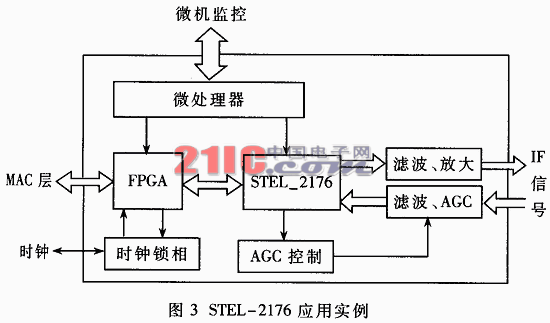Keywords: broadband wireless access, all-digital modulation and demodulation, asymmetric transmission 1 Asymmetric transmission Broadband wireless access systems usually use the point-to-multipoint base station / user station mode. In most cases, the amount of downlink data from the base station to the user station is much larger than the amount of uplink data from the user station to the base station. If the uplink and downlink occupy the same resources, it will inevitably cause waste. In TDMA / FDD mode, a feasible transmission mode is: the uplink data adopts burst data packet mode, and the modulation mode with relatively low modulation efficiency (such as QPSK); the downlink data adopts the broadcast mode, and the modulation efficiency is relatively high The modulation method (such as 16QAM). The advantages of this asymmetric transmission are: on the one hand, it can dynamically allocate bandwidth according to the actual needs of users to improve spectrum utilization efficiency; on the other hand, it reduces the number of bits transmitted per symbol of the uplink signal, thereby reducing the burst solution of the base station Adjust the difficulty of the algorithm. A modem for a subscriber station that can meet the above requirements must have such a performance that it can demodulate a broadband continuous signal with high modulation efficiency (such as 16QAM) and can also modulate a broadband burst signal with relatively low modulation efficiency (such as QPSK) . Developing STELL-2176 is a good choice. STEL-2176 is an all-digital modulation and demodulation chip, which is compatible with IEEE 802.14, MCNS and DAVIC standards. The demodulation part can directly input the intermediate frequency analog signal up to 50MHz, the signal bandwidth can reach 8MHz, can demodulate the continuous signal of 16/64 / 256QAM; the modulation part can output the continuous / burst signal of 5MHz ~ 65MHz, the modulation method can be BPSK / QPSK / 16QAM, the rate can reach up to 40Mbps (16QAM). 3. Internal structure of STEL-2176 3.1 Demodulation section Figure 1 shows the internal structure of the demodulation part of STEL-2176, which is mainly composed of ADC (analog-to-digital conversion) module, DDC (digital down conversion) / AFC (automatic frequency control) / AGC (automatic gain control) module, filtering and clock recovery module , Adaptive equalization, FEC (forward error correction coding) module and clock module. · ADC module The analog-to-digital conversion module receives an intermediate frequency analog signal with a center frequency of up to 50 MHz input into STEL-2176, and after band-pass sampling, obtains a sub-IF digital signal with a center frequency of 6 MHz to 7 MHz. · DDC / AFC / AGC module AFC roughly estimates the signal carrier, and then the carrier error signal fed back by the back-end adaptive equalizer fine-tunes the carrier LO frequency to obtain the relevant carrier. The DDC receives 6MHz ~ 7MHz sub-IF digital signals and demodulates the I and Q baseband signals through the relevant carrier. At the same time output AGC control signal, used to control the signal strength of off-chip IF and RF analog signals. · Filter and clock recovery module The baseband signals of I and Q pass the SRPC (root mean square raised cosine) filter of alph = 0.112 ~ 0.20 to eliminate inter-symbol interference, and then recover the symbol rate from the signal, the error is less than 100ppm. · Adaptive equalization In addition to eliminating all kinds of channel interference (multipath effect, amplitude modulation interference, frequency modulation interference, phase noise, etc.), adaptive equalization also feeds back carrier error signals to fine-tune the phase difference and small frequency difference of the carrier. · FEC module The forward error correction coding module receives the demodulated I and Q signals, performs constellation point mapping, restores the data, and then decodes the frame structure corresponding to the modulation end, and then performs deinterleaving, channel decoding (RS code), and descrambling , The original signal is output in serial or parallel mode, and the signal of MPEG-2 structure can be output. The clock module generates various clock signals required by the demodulation part from the sampling clock and the recovered symbol clock. 3.2 Modulation section Figure 2 shows the internal structure of the modulation part of STEL-2176, mainly composed of data receiving and channel coding module, constellation point mapping module, FIR filter and interpolation filter, modulation module, DAC (digital-to-analog conversion) module, clock module, etc. . · Data receiving and channel coding module Receive the serial input original data and perform channel coding (RS code), including interleaving and scrambling. These processes are all optional. · Constellation point mapping module The serial bit stream is mapped to the constellation point of the specified constellation diagram, and it is output in two ways of I and Q. · FIR filter and interpolation filter The two signals of I and Q are respectively filtered by the shaping filter (32-level FIR filter), and then output to the interpolation filter. The interpolation filter greatly increases the sampling frequency of the signal to meet the requirements of the carrier signal greater than 2 times, matching the rate required for quadrature modulation. · Modulation module The modulation module is a quadrature modulator composed of DDS (Direct Digital Synthesizer) and multiplier. The two signals of I and Q are respectively multiplied by the SIN and COS carrier signals generated by DDS and output after synthesis. · Digital-to-analog conversion module Finally, the digital signal is converted into an intermediate frequency analog modulation signal output, and the signal at this time has a mirror signal relative to the frequency of the main clock, that is, the output analog signal needs to be filtered off-chip. · Clock module The clock module synchronizes with the external clock and generates various clock signals required by the modulation section. 3.3 Monitoring section Receive external configuration commands serially or in parallel through the monitoring module of STEL_2166 and send status information. The monitoring of STEL_216 is achieved by accessing its internal registers. 4 Technical characteristics of STEL-2176 STEL-2176 uses all-digital modulation and demodulation technology, compared with traditional modems, it has advantages in system stability, reliability, and transmission rate, carrier rate and flexibility of modulation mode. 4.1 Chip technology with high integration and low power consumption STEL-2176 uses CMOS chip technology with a line width of 0.35μm, which has high integration and improves the stability and reliability of the system; the working voltage is lower + 3.3V, which greatly reduces the chip power consumption and is flexible at the interface Ground provides an optional I / O voltage (+ 5V / + 3.3V). 4.2 Broadband ADC / DAC This is the iconic technology of all-digital modulation and demodulation technology. It converts analog signals to digital signals at the front end of the signal channel as much as possible to fully play the role of digital signal processing technology. STEL-2176 uses 10bit ADC and DAC, and can process analog signals with a bandwidth of nearly 10MHz. Because of the use of band-pass sampling technology, the center frequency of the analog signal can reach tens of megahertz. 4.3 Using DDS technology and multi-rate signal processing algorithm All-digital modems generally use DDS technology and multi-rate signal processing algorithms, so that the system can get almost continuous clock signals of various frequencies under a single reference clock. Because the reference source is the same, these clocks are frequency dependent. Using these clock signals, different carrier frequencies, bit rates and control signals can be obtained. In addition, when the transmission signal is processed in the digital baseband, multi-rate signal processing algorithms such as extraction and interpolation are used to achieve the matching of the signal rate between different digital processors. In this way, multi-rate transmission signals and multi-mode modulation signals can be realized. 4.4 Digital demodulation algorithm For the receiving part of a communication system, the most important thing is synchronization, so carrier and timing recovery is necessary. The core of the digital demodulation algorithm is carrier and timing recovery, which is also a key issue in the design of all-digital modems. STEL-2176 restores the timing first. On the basis of timing, the carrier is restored with a complete feedback structure: first use the NDA (non-data-assisted) algorithm to make a rough estimate of the larger frequency difference, and the estimated error is fed into the AFC (automatic frequency Control) to make the local oscillator track a larger frequency difference, then use the DD (data-oriented) algorithm to estimate the phase difference and small frequency difference, feed into the PL (phase locked loop) to control the local oscillator, and track the residual phase difference of the modulated signal carrier. The characteristic of the STEL-2176 digital demodulation algorithm is that it does not require a known information symbol-the preamble, but it requires a large amount of calculations and takes a long time to resume synchronization. It can only be used for continuous demodulator. 5 Application examples of STEL-2176 in broadband wireless access system Figure 3 shows the principle block diagram of a subscriber station modem in a point-to-multipoint broadband wireless access system. The microprocessor AT89C51 completes the monitoring and configuration of the system, including the configuration of the working parameters of STELL-2176 and the loading of FPGA initial parameters. FPGA completes the interaction with the MAC layer. The receiving end STEL-2176 is set to input an intermediate frequency analog signal of 44MHz, the information rate is 9.92MHz, and the demodulation method is 16QAM. After passing through the band-pass filter and AGC, the intermediate frequency signal is input to STEL-2176, the data output by STEL-2176, and the demodulation clock are input to FPGA to perform baseband processing. The transmitting end STEL-2176 is set to output an intermediate frequency analog signal of 44 MHz, the information rate is 5.12 MHz, and the modulation mode is burst QPSK. The FPGA performs baseband processing, generates burst data packets, and outputs them to the STEL-2176, and controls the STEL-2176 output signal. The intermediate frequency analog signal is filtered and amplified and then output to the ODU (outdoor unit) device. The system additionally uses STEL-1109 as a base station downlink modulator to complete 16QAM continuous modulation; uses STELL-9257 as a base station uplink demodulator to complete QPSK burst demodulation, forming a complete set of asymmetric transmission point-to-multipoint Broadband wireless access system has proved feasible. The system uses a series of devices such as STEL-2176 and FPGA, which greatly simplifies the system hardware and improves the reliability and stability of the system. In addition, due to the high efficiency of spectrum utilization and flexible configuration of STEL-2176, it is very convenient and effective to use STEL-2176 as a modem of a subscriber station in a point-to-multipoint broadband wireless access system. Lifepo4 Cells,Li-Ion Battery,Deep Cycle Lifepo4 Battery,Rechargeable Lifepo4 Battery Zhejiang Xinghai Energy Technology Co.,Ltd , https://www.headwayli-battery.com
2 Introduction to STEL-2176 
· Clock module 
The advantages of this flexibility are fully reflected in the application of STEL-2176.
Application of all-digital modem STEL-2176 in asymmetric transmission system
Abstract: The structure, function and technical characteristics of the all-digital modem STEL-2176 are introduced, and its application examples in point-to-multipoint broadband wireless access system are given. In this system, STEL-2176 is used as the modem of the subscriber station, and the asymmetric transmission mode is adopted to realize digital demodulation of 16QAM signal and digital modulation of QPSK signal.